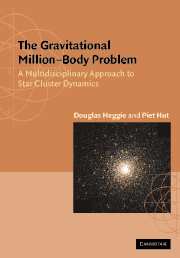Book contents
- Frontmatter
- Contents
- Preface
- PART I INTRODUCTIONS
- PART II THE CONTINUUM LIMIT: N → ∞
- PART III MEAN FIELD DYNAMICS: N = 106
- 10 Violent Relaxation
- 11 Internal Mass Loss
- 12 External Influences
- PART IV MICROPHYSICS: N = 2
- PART V GRAVOTHERMODYNAMICS: N = 106
- PART VI GRAVITATIONAL SCATTERING: N = 3
- PART VII PRIMORDIAL BINARIES: N = 4
- PART VIII POST-COLLAPSE EVOLUTION: N = 106
- PART IX STAR CLUSTER ECOLOGY
- Appendix A A Simple N-Body Integrator
- Appendix B Hints to Solution of Problems
- References
- Index
10 - Violent Relaxation
Published online by Cambridge University Press: 05 June 2012
- Frontmatter
- Contents
- Preface
- PART I INTRODUCTIONS
- PART II THE CONTINUUM LIMIT: N → ∞
- PART III MEAN FIELD DYNAMICS: N = 106
- 10 Violent Relaxation
- 11 Internal Mass Loss
- 12 External Influences
- PART IV MICROPHYSICS: N = 2
- PART V GRAVOTHERMODYNAMICS: N = 106
- PART VI GRAVITATIONAL SCATTERING: N = 3
- PART VII PRIMORDIAL BINARIES: N = 4
- PART VIII POST-COLLAPSE EVOLUTION: N = 106
- PART IX STAR CLUSTER ECOLOGY
- Appendix A A Simple N-Body Integrator
- Appendix B Hints to Solution of Problems
- References
- Index
Summary
Equilibrium and stability
Mathematicians classify equilibria in various ways. There are, for example, unstable equilibria, which are rarely found in nature, but are important in the theoretical understanding of a complicated dynamical system. Of greater practical importance are stable equilibria. The definition of this concept amounts to saying that, if the system is disturbed slightly from the equilibrium, then it remains in the vicinity of the equilibrium. In nature, however, stable equilibria often exhibit a still stronger behaviour, which mathematicians classify as asymptotic stability. This means that the disturbed system returns to the equilibrium state from which it was disturbed. This happens commonly in nature because of dissipative forces. The process of returning to equilibrium is often referred to as relaxation, and it is one with which we are all familiar (late at night).
With this background it is astonishing that relaxation plays such a central role in stellar dynamics. Not only is there no dissipation in the gravitational many-body problem, there is no equilibrium either. It is true that one can think of some highly artificial solutions which can be regarded as equilibria. The Euler–Lagrange solutions of the three-body problem, in which the three stars appear to be at rest in a uniformly rotating reference frame, come into this class, and, from a more general point of view it may be fruitful to regard a periodic solution as a generalised equilibrium. But even where these solutions are stable, there is no question of asymptotic stability.
- Type
- Chapter
- Information
- The Gravitational Million–Body ProblemA Multidisciplinary Approach to Star Cluster Dynamics, pp. 92 - 102Publisher: Cambridge University PressPrint publication year: 2003



